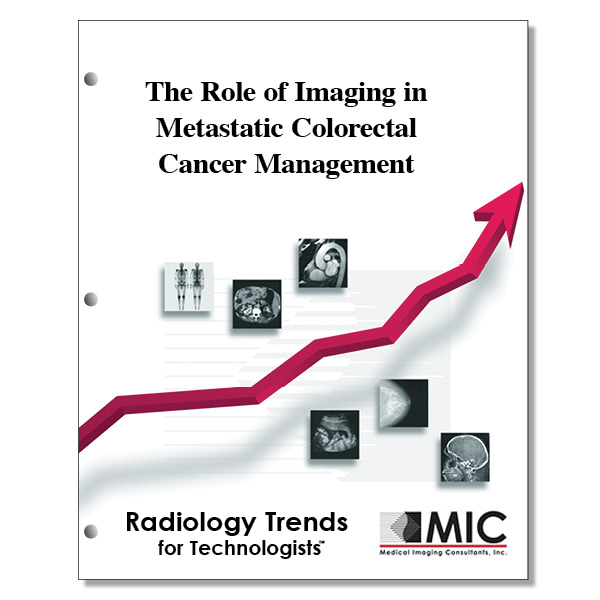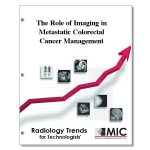

The Role of Imaging in Metastatic Colorectal Cancer Management
A review of the management of metastatic colorectal cancer and the role of imaging in treatment strategy.
Course ID: Q00419 Category: Radiology Trends for Technologists Modalities: CT, MRI, Nuclear Medicine, PET, Radiation Therapy2.75 |
Satisfaction Guarantee |
$29.00
- Targeted CE
- Outline
- Objectives
Targeted CE per ARRT’s Discipline, Category, and Subcategory classification for enrollments starting after May 9, 2023:
[Note: Discipline-specific Targeted CE credits may be less than the total Category A credits approved for this course.]
Computed Tomography: 1.00
Procedures: 1.00
Abdomen and Pelvis: 1.00
Magnetic Resonance Imaging: 1.00
Procedures: 1.00
Body: 1.00
Nuclear Medicine Technology: 1.00
Procedures: 1.00
Endocrine and Oncology Procedures: 1.00
Registered Radiologist Assistant: 2.75
Procedures: 2.75
Abdominal Section: 2.75
Sonography: 1.00
Procedures: 1.00
Abdomen: 1.00
Radiation Therapy: 2.75
Patient Care: 2.75
Patient and Medical Record Management: 2.75
Outline
- Introduction
- Imaging of Metastases in CRC
- Ultrasonography
- Multidetector CT
- MR Imaging
- PET/CT
- Management of mCRC
- Surgery in mCRC
- Role of Imaging in Surgical Planning for mCRC
- Liver-directed Therapies in mCRC
- Role of Imaging in Liver-directed Therapies for mCRC
- Systemic Chemotherapy in mCRC
- Chemotherapeutic Regimens
- Novel MTTs
- Role of Imaging in Systemic Chemotherapy
- Complications and Toxicities Associated with Treatment of mCRC
- Complications Associated with Liver-directed Therapies
- Conclusion
Objectives
Upon completion of this course, students will:
- list the compounds in the FOLFOX and FOLFIRI chemotherapeutic regimens
- identify the most common site of CRC metastasis
- recognize the imaging modalities that have supplanted US in the evaluation of colorectal cancer
- understand the barriers to performing contrast-enhanced US for the assessment of CRC liver metastases
- describe the sensitivity of intraoperative US in the evaluation of colorectal cancer
- identify the most commonly used imaging modality in the workup of patients with metastatic colorectal cancer
- understand the timing of the phases of enhancement following administration of intravenous CT contrast material
- describe the CT imaging findings of pseudomyxoma peritonei
- describe the appearance of hepatic metastases on T1- and T2-weighted MR imaging
- list the potential routes of excretion of intravenous MR contrast agents
- describe the enhancement pattern of hepatocyte-specific intravenous MR contrast agents
- describe the appearance of metastatic lesions on diffusion-weighted MR imaging
- list the conditions that may produce false-negative PET/CT results during imaging of mCRC
- identify the only definitive treatment for metastatic colorectal cancer
- understand the goal of conversion chemotherapy
- list the major determinants of liver metastasis resectability
- recognize the imaging modalities capable of performing volumetry that is used to estimate the volume of liver remnants following resection
- understand the timeframe associated with preoperative portal vein embolization
- describe the liver-directed therapy capable of achieving a selective high-dose delivery of chemotherapeutic drugs
- describe the liver-directed therapy that involves the administration of yttrium-90 microspheres
- recognize the most widely used local ablative procedure for colorectal cancer
- list the imaging modalities used to guide liver-directed therapies
- describe the imaging findings of periablational hyperemia
- list the CRC MTTs that have an antiangiogenesis effect
- describe the percentage of CRC cases that demonstrate mutations in the KRAS intracellular signaling protein
- list the CRC MTTs that bind to vascular endothelial growth factor (VEGF) receptors
- identify the mCRC treatments that can result in wound dehiscence
- list the mCRC treatments that are associated with cholecystitis
- identify the most widely used imaging modality in the assessment of mCRC treatment response
- describe the imaging findings associated with a good or optimal morphologic response to treatment in liver metastases
- identify the main limitation of dynamic contrast-enhanced CT for assessment of treatment response
- identify the MR imaging technique that can help predict treatment response by measuring the volume transfer constant K-trans and rate constant K-ep
- list the imaging modalities that are recommended for assessment of treatment response
- recognize the complications associated with cetuximab administration
- describe the major complications associated with percutaneous ablation
